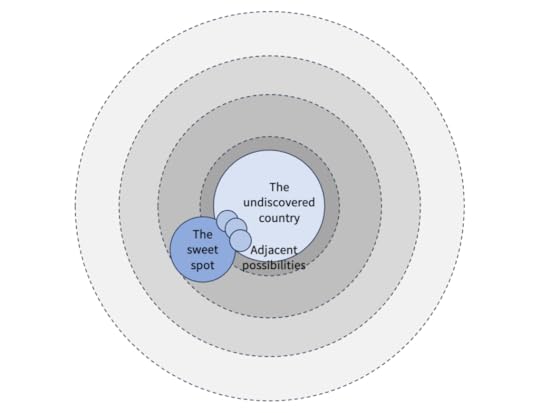From Flow to Business Agility
(Comment on LinkedIn | Hacker News)
Preamble: You may have noticed that I don’t use words like ‘waste’, ‘improvement’, or ‘flow’ nearly as much as my history in Lean-Agile [1, 2] might suggest. Recently [3] I expressed what could be interpreted as a lack of enthusiasm for a more recent term, ‘cognitive load’. Not to put fuel on the fire but to put those and similar terms into what I think is their proper context, here’s where I’m coming from.
Pick a scope, any scope. Bigger is better perhaps – your whole organisation even – but what I’m about to share works for small scopes too, your team, say.
Now picture its sweet spot, a metaphor for the set of its most desirable states or configurations: the right people working on the right things, the right conversations happening at the best possible moment, needs anticipated, met at just the right time [4].

Enjoy that for a moment.
What stops that? What gets in the way? Well, here’s how it often plays out.
Decisions on what work to start aren’t always optimal, and to correct past decisions, new work may need to be started. Already, and despite good intentions, we’re out of that sweet spot.

As a consequence perhaps of those earlier decisions, some of what is in progress can’t be finished, so yet more things get started. Inevitably, before this increasing pile of work finishes, new work arrives, and some of that gets started too.

Those “right conversations”? Can’t you see that we’re busy? Now there’s work being done by people who don’t have all the customer or business context they need. This results in yet more work – rework. With all of that going on, little thought can be spared for the question of how the organisation itself impedes those conversations.

“Needs anticipated, met at just the right time?” You’re kidding me! People overburdened, work lying around not getting finished, staff and customers alike frustrated by delays, the business having to finance not only the productive, value-adding work, but the delays and the rework too. That sweet spot turned out to be a tiny island in an ocean of other, far less desirable states.

“Needs anticipated, met at just the right time?” You’re kidding me! People overburdened, work lying around not getting finished, staff and customers alike frustrated by delays, the business having to finance not only the productive, value-adding work, but the delays and the rework too. That sweet spot turned out to be a tiny island in an ocean of other, far less desirable states.
The improvement story runs in the opposite direction. Focusing on finishing. Learning to be more careful about what gets started when. Reducing overburden. Testing assumptions sooner [5]. Improving quality. Reducing rework. These are measures that promote flow – better for the people doing the work, better for the customer, better for the business – a triple win!
So far, so conventional. Is that all there is to it? Of course not. If it were enough simply to manage the process more efficiently, why not just outsource it or sell off the offending product line? Let others find the efficiencies! That can’t be the right answer for most teams, most product lines, or most organisations – those with any kind of future ahead of them at least – but if the logical conclusion of that kind of thinking is a race to the bottom, there must be something that we are missing. Clearly, there’s a trap here.
With some justification, the missing piece is often assumed to be purpose. But the issue is even more basic than that. It is viability. Excluding perhaps project organisations whose mission and timescale are bounded, most organisations would not wish to pursue purpose in ways incompatible with survival, and efficiency is only part of that challenge.
John Boyd (of OODA loop fame) [6], described the challenge as one of “developing our capacity for independent action in a changing environment”. If there is a better definition of the pursuit of viability than that, I haven’t found it. Understand (as Boyd did) the competitive nature of that challenge, and it describes business agility very well too. Without going too deeply here into the study of viable systems [7] (fascinating, but outside the scope of this article), let’s try to make that actionable.
First of all, let’s see all that waste (including other forms of waste not identified above) not only as impediments to flow (as measured by things like lead time, flow efficiency, etc), but as drains on the organisation’s decision-making capacity. All that extra workload, the constant context switching, the quality issues, the dependencies, the frustration, the untested assumptions, the rework, and so on and so on – all of that needs to be dealt with, consuming the decision-making capacity of every participant in the system.
Conversely, improving the system releases decision-making capacity. A good thing no doubt, but improve the system enough it might seem to someone obsessed with efficiency that we now have excess capacity. That’s people we no longer need, right? It’s that trap again!
To understand why that decision-making capacity is so vital, we must understand that sweet spot not as the ultimate goal, but as a local optimum. Adjacent to it are other possibilities – possibilities that people now have the capacity to explore. And what lies beyond those? Not just optimisations to the end-to-end process, but new communication channels that might one day lead to new organisational structures. Not just changes in practice, but innovations and understandings that might lead to radically new solution ideas. Not just improved performance, but the organisation reaching a different understanding of itself and its position in the world.

That is what “developing our capacity for independent action in a changing environment” looks like. Turning that around, if you’re not developing your capacity for independent action, sooner or later you run out of options, and it’s game over. That applies at every level: to the organisation, to its larger structures (teams-of-teams, value streams, cross-cutting structures, and so on) down even to its teams and their team members. It applies to you. At none of these levels do you want your capacity for independent action to be so constrained that effectively you’re out of options. You don’t want to be out of options, and you don’t want that happening around you either.
You thought business agility was only about speed? Think again. Business agility comes from the capacity to keep creating options (ie to strategise), to select and test the best of them at the right time and with sufficient pace (I hesitate to call that execution), and to keep learning from the experience. To sustain it, the organisation must keep striking the right balances between delivering to existing commitments, discovering new opportunities, and developing the capacities they will need. At any level of organisation, some of those activities may (rightly) bring into challenge its structure, its purpose, even its identity. All of that demands decision-making capacity at every level [7, 8].
Decision-making capacity is a fundamental constraint on organisations. Without it, needs and challenges go unrecognised. Opportunities go unexplored. Options don’t get generated. Good options don’t get exercised at the right time or with the right priority. It is provisioned not only by reducing wasteful drains on it (reducing what is popularly known as cognitive load), but by enabling it to be exercised effectively. Therein lies the organisational challenge, because it depends on the availability of opportunities to participate and on situational awareness, both of which are constrained by far more than workload [9].
Ask yourself this: what is stopping people from deciding for themselves to do the right thing, to deviate where necessary from accepted practice, to seek to understand their work more contextually, to empathise more deeply with the customer, to interact with different people, to enter into new collaborations, to self-organise around new challenges – ie to innovate process-wise, product-wise, or organisationally? This is the organisation exercising and developing its capacity for independent action, but if the cost is too high or the capacity simply isn’t there, it won’t happen. Or perhaps at some level it is happening, but the surrounding organisation is too focused on other things for it to make a difference.
The truth is that no formal process or organisational structure can guarantee you the decision-making capacity to deal with every situation that your organisation will face. In a changing environment, they may hinder as much as they help. Whether for reasons material or psychological, the people closest to the challenge may feel constrained from acting. Lacking context, others around them may fail to lend their support. The wider organisation may be impeded structurally from recognising that the problem or opportunity even exists.
Yes, it’s important to seek efficiencies, to reduce waste, to pursue flow, to iterate and learn faster. But don’t see it only as a productivity play. If you aren’t quickly seeing the improvements spill over into a more profound kind of capacity [10], it could be that you aren’t helping your organisation half as much as you think. Your organisation’s reserves are enormous. Is it time you released them?
(Comment on LinkedIn | Hacker News)
References[1] Kanban from the Inside (2014)
[2] Right to Left: The digital leader’s guide to Lean and Agile (2019, audiobook 2020)
[3] I may be on my own here but… (linkedin.com)
[4] Borrowing from Agendashift True North (agendashift.com/resources/true-north)
[5] Cockburn, Alistair, Elements to a Theory of Software Development (HaT Technical Report, 2016)
[6] Boyd, John R., Destruction and Creation (U.S. Army Comand and General Staff College, 1976)
[7] Everywhere all at once: Introducing the Deliberately Adaptive Organisation (agendashift.com/resources/everywhere-...)
[8] Adaptive Organisation (I): Business agility at every scale (agendashift.com/academy/adaptive-orga...)
[9] Between spaces, scopes, and scales: What the scaling frameworks don’t tell you (agendashift.com/keynotes#between)
[10] Explaining the “unreasonable effectiveness” of Agile (blog.agendashift.com)
AcknowledgementsFor their encouragement, feedback, and comments as this post developed over the holiday period I am grateful to the following: Andrea Place, Badre Srinivasan, Cat Hicks, Craig Lucia, Daniel Walters, David Michel, Dickson Alves de Souza, Dustin Parham, Elizabeth Jones, John Obelenus, Karl Scotland, Kyle Bird, Leif Hanack, Matt Mitchell, Matthew White, Michael Cicotti, Nader Talai, Nariman Dorafshan, Ricardo Alvarez, Robert Howes, Sarah Whitely, and Shern Tee. Thank you all.
Upcoming events (most of them free)January:
11 January, online, 15:00 GMT, 16:00 CET, 10am ET:Free webinar/AMA: How do we keep bringing outcomes in the foreground? 25 January, online, 15:00 GMT, 16:00 CET, 10am ET:
Experience/practice session: Adaptive Organisation assessment
February:
6-14 February, online, Tuesday & Wednesday afternoons (UK time):Leading with Outcomes: Train-the-Trainer / Facilitator (TTT/F) *15 February, online, 15:00 GMT, 16:00 CET, 10am ET:
Free webinar/AMA: Where to start? Where next? 22 February, online, 15:00 GMT, 16:00 CET, 10am ET:
Experience/practice session: Agendashift Delivery Assessment (mini edition)
March:
07 March, online, 15:00 GMT, 16:00 CET, 10am ET:Free webinar/AMA: Obstacles Fast and Slow
*For the February TTT/F, ping me for coupon codes if any of the following apply:
Past TTT/F participants can join again for free (a popular perk)Past participants of Leading in a Transforming Organisation get 60% offEmployees in public sector, education, and non-profit organisations get 40% offMembers of the old partner programme get 30% offLast but not least, Agendashift Academy subscribers get subscription-specific discounts also
Leading with Outcomes from the Agendashift Academy
“Leadership and strategy in the transforming organisation”
Leading with Outcomes is our modular curriculum in leadership and organisation development. Each module is available as self-paced online training or as private, instructor-led training (online or in-person). Certificates of completion or participation according to format. Its four modules in the recommended order:
Leading with Outcomes: Foundation Adaptive Organisation, two parts: Part I: Business agility at every scale Part II: Between spaces, scopes, and scales Inside-out Strategy: Fit for maximum impact Outside-in Strategy: Positioned for successIndividual subscriptions from £24.50 per month after a 7-day free trial, business subscriptions from £259 per month for 15 individual subscribers, with discounts available for employees and employers in the government, healthcare, education, and non-profit sectors.
To deliver Leading with Outcomes yourself, see our Authorised Trainer and Authorised Facilitator programmes. Our next TTT/F trainings take place in February (online).
Agendashift : Serving the transforming organisation
: Serving the transforming organisation
Links: Home | Subscribe | Events | Media | Contact | Mike
Agendashift Academy: Leading with Outcomes | Trainer and Facilitator Programmes | Store
At every scope and scale, developing strategy together, pursuing strategy together, outcomes before solutions, working backwards (“right to left”) from key moments of impact and learning.



